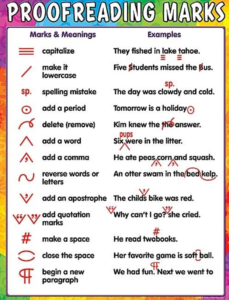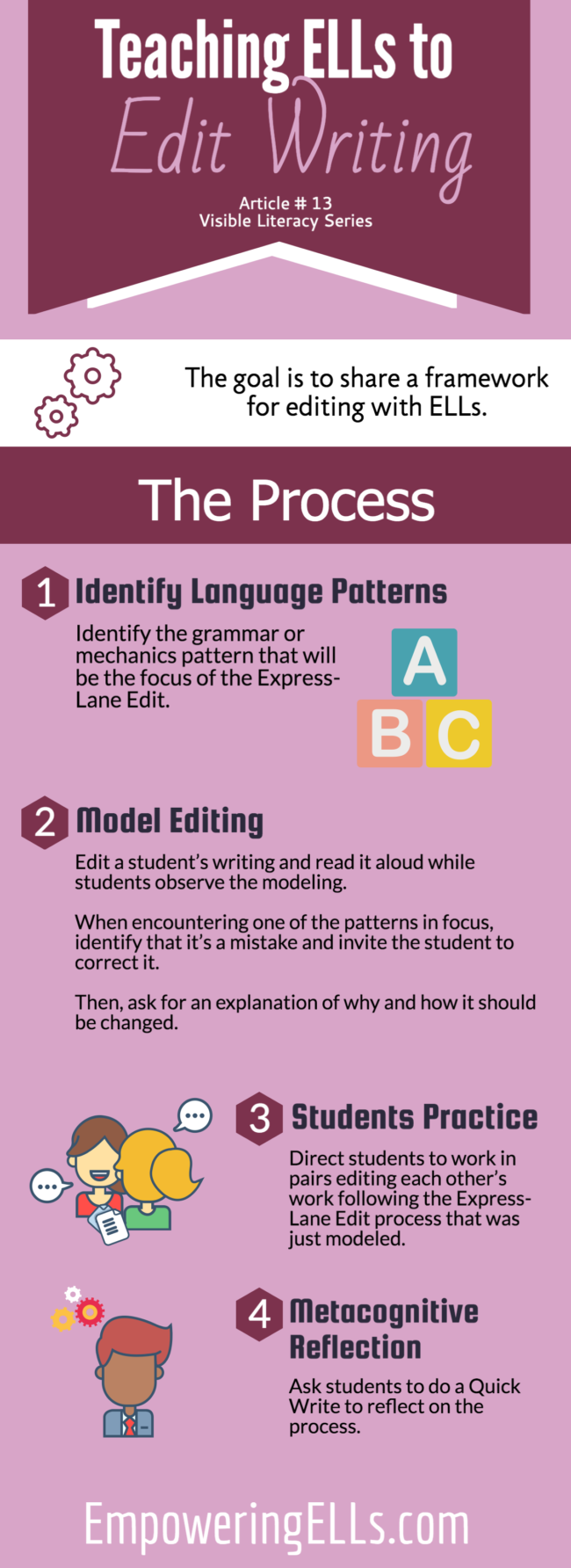Goal
This is the sixth and final installation of the writing instruction articles in the Visible Literacy series. If you have been following the writing articles, I have taken you through the process of developing writing fluency through Quick Writes, deconstructing the writing prompt using mind maps, outlining ideas, deconstructing the text type, and revising using the STAR revision framework. Now, in this week’s article, we’re ready to have the ELs copy-edit their text for grammar and mechanics.
Research Says
You have probably noticed that I’m a process-oriented teacher who uses modeling to explicitly teach ELs academic language. I try to create a shared learning context by demonstrating a skill and inviting students to participate in the process. Lastly, I encourage them to “step-back” from the learning experience to reflect on what they learned. Research indicates that my approach to teaching language is an effective method because language is learned through social interactions where the teacher and the learner shares a context (Vygotsky, 1978; Halliday, 1978; Painter, 2000; Martin & Rose, 2012).
Within this context, modeling becomes a tool that scaffolds learning and metacognitive reflection internalizes skills (Gibbons, 2009; Hattie, 2012). The editing process that I’ll share in this article again uses this model of language instruction.
Past Practices
Mistake # 1: Editing Marks. I was “taught” to edit by looking at the symbols my teachers had marked all over my paper. These marks represented some grammatical or mechanical error I had committed and needed to be fixed.
We often teach the way we were taught, so I photocopied an editing mark list like the one below and stapled it to the back of my students’ compositions, which were full of green editing marks. I used green because I thought I wanted to be different than my teachers who used a blood red pen.
I could have used all the colors of the rainbow to mark up my students’ writing, and it still would not make a positive difference. Teachers who use editing marks wrongly assume that students already know how to capitalize a word, indent a paragraph, add an adjective, and so forth.
However, simply pointing out the types of errors fails to teach how to use language .
Mistake # 2: Peer-editing. This was another beloved strategy that my primary school teachers often used. They would have us pair with another person to edit each other’s writing. We each had our own editing marks sheet to help us give feedback.
The major problem with this approach was that my teachers assumed that I had already mastered the grammar and mechanic patterns enough to recognize when they were wrong and assess how to correct them. But one cannot teach what one does not know.
Current Practices
The principle reasons why these practices were ineffective are because 1) I did not directly teach grammar and mechanics patterns first, and 2) I did not teach the editing process. I learned how to do both of these things after reading Mechanically Inclined by Jeff Anderson (2005). On Stehnhouse Publishing’s website about Anderson’s book, they summarized the following four key elements of teaching grammar and mechanics:
- “short, daily instruction in grammar and mechanics within writer’s workshop;
- using high-quality mentor texts to teach grammar and mechanics in context;
- visual scaffolds, including wall charts, and visual cues that can be pasted into writer’s notebooks;
- regular, short routines, like ‘express-lane edits,’ that help students spot and correct errors automatically”
In this post, I’ll share my adaptation of Anderson’s Express-Lane Editing to teach the editing process to ELs. After describing the steps, I’ll explain why it is so valuable for my students.
Step 1: Identify Language Patterns
I ask one student to volunteer a paragraph to be edited during the modeling to the class. The remaining students fishbowl around me and the student volunteer. Their job is to describe the steps that I take during the peer-editing process. I project the selected paragraph on the screen and begin by saying, “I’m going to focus on two things during this peer- edit: 1) capitalization of names and 2) correct full-stop placement.” I selected only two patterns to edit because brevity is one of the principles of Express-Lane Edits – focusing on only a few items as to not overwhelm students with too many things to keep in mind.
I picked capitalization and full-stop placements specifically because I reviewed those punctuation issues during our Visible Reading process. In the next post, I will explain more about how to teach grammar and mechanics to ELLs within context.
Step 2: Model Editing
My version of peer-editing is not the same as those my teachers once used in primary school. Their more traditional approaches expected me to work alone -editing my friend’s text without having any discussion about it. I would “edit” the document and return it to them without much interchange. This is NOT the approach we are modeling with Express-Lane Edits.
After asking one student to be my volunteer. I read his or her text aloud, and when I see a capitalization or full-stop error, I pause and say, “Hey, Lilly. I think this needs to be edited [pointing to the uncapitalized word “thailand”]. What do you think we should do?” I hope Lilly will respond by saying, “Oh, I have to capitalize the word “thailand” because it is a name of a country.”
Understanding is another KEY element of Express-Lane Edits. I, as the peer editor, understand the grammar mistake, but I want to teach Lilly to understand it too, so I ask her questions to help her learn. I encourage her to figure out how she would edit the word “thailand” instead of commanding her to capitalize the ‘t’. Thus, peer-editing serves as a teaching opportunity, not just a “correct-the-mistake” exercise .
After we finish editing the paragraph, I ask the fishbowl students what behaviors they observed during my editing experience with Lilly because they should also be thinking critically about the process. They should say that they observed how I identified the mistake, invited her to change it, and asked why she changed it that way.
Step 3: Students Practice
Before I let students practice what Lilly and I have modeled, we make a wall chart describing the process of editing. Students often ask, “Is it ok for us to edit things that we see but that are not in our Check-Out List?”
My response is yes, but I do not force them to have more than the two things that are the focus of the Check-Out List because this is just an “express-lane” version of editing. Developing an awareness of language is more effective than combing for mistakes . We’re just focusing on two to reinforce the process and to make editing more manageable.
Now students work in pairs to peer-edit according to my modeling, and I walk among them to monitor their progress. This is an image of Jasmine and Inseo copy-editing together using the Express-Lane Edit method. Notice that there’s only one laptop open because we want them to talk about one text at a time. The learning occurs in the conversation and negotiation about the grammar patterns in focus.
I recommend pairing students in the following pattern: Bridging with Expanding EL, Emerging with Developing, and for Beginning ELs, it’s best that the teacher works with them.
I recommend this pattern because we want students who have similar language abilities to be together because there’s a possibility that there will be a lack of comprehensible input on part of the EL with the more advanced language skills. Additionally, I have seen the more advanced language user feel frustrated that the Developing EL does not understand or cannot help find the language patterns correctly. Intentionally pair students with the same level of understanding together.
Step 4: Reflect on the Process
After they have peer-edited, I ask them to do a Quick Write about the experience to support their internalization of the process. I have them share their QWs in pairs, and then we reflect as a group. This debriefing allows me to assess their understanding of the process and identify areas of concern while allowing them an opportunity to think reflectively.
Why Express-Lane Editing
The reason why I prefer this process of teaching copy-editing is because it reinforces grammar and mechanic patterns. Express-lane editing does this because it asks the partner to identify the mistake without fixing it for students. It also invites ELs to change the mistake themselves in collaboration with a peer. The peer encourages the student to explain the correction made.
The explanation helps the ELs to internalize the grammar and mechanic patterns, so copy-editing becomes an opportunity to reinforce grammar and not just an activity to correct grammar.
Takeaways
- Writing is an invisible process.
- Editing can be made visible through modeling.
- Social interactions facilitate language acquisition.
Next Post
I hope you enjoyed this article on modeling the editing process. Teaching writing is the most difficult part of language instruction. There’s so much to think about and the process is mainly invisible – worked in our minds but produced on paper. I hope that these writing articles have described how we can make the invisible act of writing more visible for ELs through modeling and explicit instruction.
Express-Lane Editing requires direct and explicit grammar and mechanic instructions for it to function successfully. So, next week’s post will be about teaching grammar and mechanics in context of a reading workshop.
Please feel free do download this PDF for your personal use or to share with your colleagues.
References
Anderson, J. (2005). Mechanically inclined: Building grammar, usage, and style into writer’s workshop. Portland, ME: Stenhouse.
Gibbons, P. (2009). English learners academic literacy and thinking: Learning in the challenge zone. Portsmouth: Heinemann.
Halliday, M.A.K. (1978). Language as a social semiotic: The social interpretation of language and meaning. London: Edward Arnold.
Hattie, J. (2012). Visible learning for teachers: Maximizing impact on learning. London: Routledge.
Martin, J.R., & Rose, D. (2012). Learning to write, reading to learn: Genre, knowledge and pedagogy in the sydney school. Bristol: Equinox.
Painter, C. (2000). Researching first language development in children. In Unsworth [Ed.], Researching language in schools and communities: Functional linguistic perspectives (65-86).
Anderson, J. (2005). Mechanically inclined: Building grammar, usage, and style into writer’s workshop [Abstract]. Portland, MeE.: Stenhouse. Retrieved from https://www.stenhouse.com/content/mechanically-inclined
Vygotsky, L. S. (1978). Mind in society: The development of higher psychological processes. Cambridge, MA: Harvard University Press.




